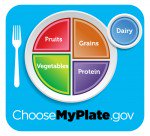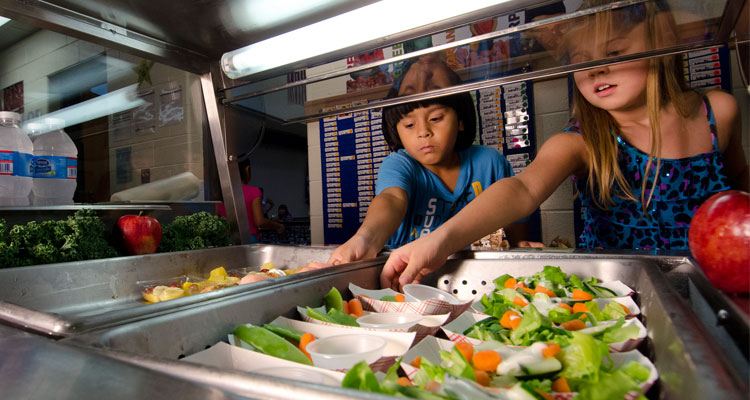A nutritious diet can do more than improve kids’ health. Better food can actually mean better grades for school children. Dr. Paul J. Veugelers and his colleagues published a study in the Journal of School Health that analyzed “diet quality and academic performance” in 5,200 elementary students. They concluded that students who ate a healthy diet that included “fruits, vegetables, grains, dietary fiber, protein, iron, calcium, and vitamin C” performed better academically and were less likely to fail a literacy test. Conversely, those with an inadequate diet were more likely to perform poorly on tests.
Other studies looked at the effects of nutrition on brain function. Not surprisingly, deficiencies in iron and other vitamins can affect cognition, which is a problem for young learners. Kids who don’t get enough iron may feel tired, dizzy, and eventually develop anemia. Even before anemia develops though, symptoms may affect school work. “A low iron level can cause decreased attention span, reduced alertness, and learning problems in children,” according to MedlinePlus. (Meat, chicken, fish, beans and spinach are all good sources of iron.)
Kids who don’t get enough B vitamins may also suffer academically as symptoms include “forgetfulness, moodiness, confusion, dizziness, and loss of alertness,” according to Dr. Donna Schwontkowski. Food sources for B vitamins vary but include the standard green leafy vegetables, fruits, eggs, grains, and fish.
Too Much of the Wrong Thing
Perhaps a more widespread problem than not getting enough of the right foods is eating too much of the wrong foods. It’s an issue that’s common in the typical American diet of processed, prepared food. Eating too much fat and sugar can also impact learning and school performance.
Too much sugar is not only unhealthy, causing obesity and other issues such as diabetes and high blood pressure, it can also lead to attention and memory problems. The “sugar high” kids get from eating candy and drinking sodas is followed by a sugar crash when the body receives too much insulin, causing fatigue and difficulties with concentration. There is some evidence to suggest that excessive sugar can even cause behavior problems and worsen ADHD symptoms.
Studies by the Society for Neuroscience found that diets high in saturated fats adversely affect memory and learning. Ironically, this is often the diet American children are fed in school, including French fries, hamburgers, fried chicken, and rich desserts. Another study from The FASEB Journal reported that “a high-fat diet over several months leads to cognitive impairment.”
Unfortunately, as is often the case, there can be a divide between lower income families and those with more means. Higher-quality food tends to be more expensive, forcing some families to purchase cheaper, less nutritious options. Sadly, some kids struggle from malnutrition due to their parents’ lack of resources. For all income levels, however, there are still smarter choices families can make when it comes to diets that can impact academic performance.
Below are some suggestions for giving your child the nutritional foundation needed to learn and succeed in school:
Make a Good Start with a Good Breakfast
 It’s called the most important meal of the day for good reason. A child who doesn’t eat breakfast will be hungry and tired—not a good foundation for learning. Children who do eat breakfast will likely have more energy and a longer attention span in class. Try to avoid the less healthy breakfast options and make nutritious choices that include grains and proteins.
It’s called the most important meal of the day for good reason. A child who doesn’t eat breakfast will be hungry and tired—not a good foundation for learning. Children who do eat breakfast will likely have more energy and a longer attention span in class. Try to avoid the less healthy breakfast options and make nutritious choices that include grains and proteins.
Include the Five Food Groups in Each Meal
 Include ingredients from at least some of the five food groups: fruit, vegetables, grains, dairy, and protein. Combining these groups will provide growing children with the nutrition they need for a full day of learning. The United States Department of Agriculture suggests varying the veggie intake, choosing “whole grain” whenever possible, and making the proteins lean. Note that half of your child’s plate should be filled with fruits and vegetables, while whole grains and healthy proteins make up the other half.
Include ingredients from at least some of the five food groups: fruit, vegetables, grains, dairy, and protein. Combining these groups will provide growing children with the nutrition they need for a full day of learning. The United States Department of Agriculture suggests varying the veggie intake, choosing “whole grain” whenever possible, and making the proteins lean. Note that half of your child’s plate should be filled with fruits and vegetables, while whole grains and healthy proteins make up the other half.
Choose Plant-Based Foods
 Try to stay away from processed foods and limit the animal-based foods in your children’s diet. A plant-based diet emphasizes fruits; vegetables; whole grains; and legumes, which include kidney beans, chickpeas, lentils, lima beans, cannellini beans, and black beans.
Try to stay away from processed foods and limit the animal-based foods in your children’s diet. A plant-based diet emphasizes fruits; vegetables; whole grains; and legumes, which include kidney beans, chickpeas, lentils, lima beans, cannellini beans, and black beans.
Play First, Eat Later
 A new study finds that kids who eat lunch after recess tend to eat more fruits and vegetables than those who eat lunch first. “When recess takes place before kids sit down to eat—instead of after—fruit and vegetable consumption increases by 54%,” according to the study by researchers at Brigham Young University and Cornell University. The logic is that kids are hungrier after exercising and feel less rushed to get out and play then they would be if recess came after lunch. While recess time isn’t something parents can usually control at brick-and-mortar schools, parents of kids in online learning environments or who homeschool may want to consider moving up playtime in their daily schedules.
A new study finds that kids who eat lunch after recess tend to eat more fruits and vegetables than those who eat lunch first. “When recess takes place before kids sit down to eat—instead of after—fruit and vegetable consumption increases by 54%,” according to the study by researchers at Brigham Young University and Cornell University. The logic is that kids are hungrier after exercising and feel less rushed to get out and play then they would be if recess came after lunch. While recess time isn’t something parents can usually control at brick-and-mortar schools, parents of kids in online learning environments or who homeschool may want to consider moving up playtime in their daily schedules.
Snack Healthy!
 Snacks can be the downfall of a student’s diet. They get hungry and grab chips, candy, or other high-fat offerings. Make snack time a chance to increase the nutrients your child gets during the day. Healthy snacks might include fruits and veggies, popcorn, or yogurt. Read Learning Liftoff’s new Snack of the Week series for healthy snack alternatives.
Snacks can be the downfall of a student’s diet. They get hungry and grab chips, candy, or other high-fat offerings. Make snack time a chance to increase the nutrients your child gets during the day. Healthy snacks might include fruits and veggies, popcorn, or yogurt. Read Learning Liftoff’s new Snack of the Week series for healthy snack alternatives.
Eating healthy might not be your children’s first priority, but there are ways to get your kids to start eating a more nutritious diet. It may be a struggle at first, but your effort may well be rewarded by seeing their grades improve along with their health! Check out these Learning Liftoff posts for recipe ideas.
Featured Image – U.S. Department of Agriculture / CC by 2.0





























































































